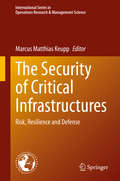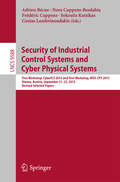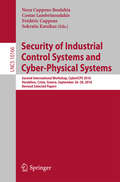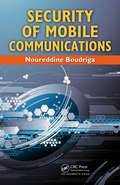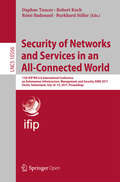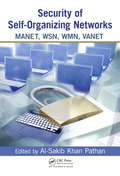- Table View
- List View
The Security of Critical Infrastructures: Risk, Resilience and Defense (International Series in Operations Research & Management Science #288)
by Marcus Matthias KeuppThis book analyzes the security of critical infrastructures such as road, rail, water, health, and electricity networks that are vital for a nation’s society and economy, and assesses the resilience of these networks to intentional attacks. The book combines the analytical capabilities of experts in operations research and management, economics, risk analysis, and defense management, and presents graph theoretical analysis, advanced statistics, and applied modeling methods. In many chapters, the authors provide reproducible code that is available from the publisher’s website. Lastly, the book identifies and discusses implications for risk assessment, policy, and insurability. The insights it offers are globally applicable, and not limited to particular locations, countries or contexts. Researchers, intelligence analysts, homeland security staff, and professionals who operate critical infrastructures will greatly benefit from the methods, models and findings presented. While each of the twelve chapters is self-contained, taken together they provide a sound basis for informed decision-making and more effective operations, policy, and defense.
Security of Cyber-Physical Systems: Vulnerability and Impact
by Hadis Karimipour Pirathayini Srikantha Hany Farag Jin Wei-KocsisThis book presents a comprehensive overview of security issues in Cyber Physical Systems (CPSs), by analyzing the issues and vulnerabilities in CPSs and examining state of the art security measures. Furthermore, this book proposes various defense strategies including intelligent attack and anomaly detection algorithms.Today’s technology is continually evolving towards interconnectivity among devices. This interconnectivity phenomenon is often referred to as Internet of Things (IoT). IoT technology is used to enhance the performance of systems in many applications. This integration of physical and cyber components within a system is associated with many benefits; these systems are often referred to as Cyber Physical Systems (CPSs).The CPSs and IoT technologies are used in many industries critical to our daily lives. CPSs have the potential to reduce costs, enhance mobility and independence of patients, and reach the body using minimally invasive techniques. Although this interconnectivity of devices can pave the road for immense advancement in technology and automation, the integration of network components into any system increases its vulnerability to cyber threats. Using internet networks to connect devices together creates access points for adversaries. Considering the critical applications of some of these devices, adversaries have the potential of exploiting sensitive data and interrupting the functionality of critical infrastructure.Practitioners working in system security, cyber security & security and privacy will find this book valuable as a reference. Researchers and scientists concentrating on computer systems, large-scale complex systems, and artificial intelligence will also find this book useful as a reference.
Security of Data and Transaction Processing: A Special Issue of Distributed and Parallel Databases Volume 8, No. 1 (2000)
by Vijay Atluri Pierangela SamaratiSecurity of Data and Transaction Processing brings together in one place important contributions and up-to-date research results in this fast moving area. Security of Data and Transaction Processing serves as an excellent reference, providing insight into some of the most challenging research issues in the field.
Security of Industrial Control Systems and Cyber Physical Systems: First Workshop, CyberICS 2015 and First Workshop, WOS-CPS 2015 Vienna, Austria, September 21–22, 2015 Revised Selected Papers (Lecture Notes in Computer Science #9588)
by Adrien Bécue Nora Cuppens-Boulahia Frédéric Cuppens Sokratis Katsikas Costas LambrinoudakisThis book constitutes the refereed proceedings of the First Conference on Cybersecurity of Industrial Control Systems, CyberICS 2015, and the First Workshop on the Security of Cyber Physical Systems, WOS-CPS 2015, held in Vienna, Austria, in September 2015 in conjunction with ESORICS 2015, the 20th annual European Symposium on Research in Computer Security. The 6 revised full papers and 2 short papers of CyberICS 2015 presented together with 3 revised full papers of WOS-CPS 2015 were carefully reviewed and selected from 28 initial submissions. CyberICS 2015 focuses on topics covering ICSs, including cyber protection and cyber defense of SCADA systems, plant control systems, engineering workstations, substation equipment, programmable logic controllers, PLCs, and other industrial control system. WOS-CPS 2015 deals with the Security of Cyber Physical Systems, that exist everywhere around us, and range in size, complexity and criticality, from embedded systems used in smart vehicles, to SCADA systems in smart grids to control systems in water distribution systems, to smart transportation systems etc.
Security of Industrial Control Systems and Cyber-Physical Systems: Second International Workshop, CyberICPS 2016, Heraklion, Crete, Greece, September 26-30, 2016, Revised Selected Papers (Lecture Notes in Computer Science #10166)
by Nora Cuppens-Boulahia Costas Lambrinoudakis Frédéric Cuppens Sokratis KatsikasThis book constitutes the refereed proceedings of the Second Conference on Security of Industrial Control Systems and Cyber-Physical Systems, CyberICPS 2016, held in Crete, Greece, in September 2016 in conjunction with ESORICS 2016, the 21st annual European Symposium on Research in Computer Security. The 5 revised full papers 2 invited papers presented were carefully reviewed and selected from 18 initial submissions. CyberICPS 2016 focuses on topics related to the management of cyber security in industrial control systems and cyber-physical systems, including security monitoring, trust management, security policies and measures.
Security of Internet of Things Nodes: Challenges, Attacks, and Countermeasures (Chapman & Hall/CRC Internet of Things)
by Chinmay ChakrabortyThe book Security of Internet of Things Nodes: Challenges, Attacks, and Countermeasures® covers a wide range of research topics on the security of the Internet of Things nodes along with the latest research development in the domain of Internet of Things. It also covers various algorithms, techniques, and schemes in the field of computer science with state-of-the-art tools and technologies. This book mainly focuses on the security challenges of the Internet of Things devices and the countermeasures to overcome security vulnerabilities. Also, it highlights trust management issues on the Internet of Things nodes to build secured Internet of Things systems. The book also covers the necessity of a system model for the Internet of Things devices to ensure security at the hardware level.
Security of Internet of Things Nodes: Challenges, Attacks, and Countermeasures (Chapman & Hall/CRC Internet of Things)
by Chinmay Chakraborty Sree Ranjani Rajendran Muhammad Habibur RehmanThe book Security of Internet of Things Nodes: Challenges, Attacks, and Countermeasures® covers a wide range of research topics on the security of the Internet of Things nodes along with the latest research development in the domain of Internet of Things. It also covers various algorithms, techniques, and schemes in the field of computer science with state-of-the-art tools and technologies. This book mainly focuses on the security challenges of the Internet of Things devices and the countermeasures to overcome security vulnerabilities. Also, it highlights trust management issues on the Internet of Things nodes to build secured Internet of Things systems. The book also covers the necessity of a system model for the Internet of Things devices to ensure security at the hardware level.
Security of Mobile Communications
by Noureddine BoudrigaThe explosive demand for mobile communications is driving the development of wireless technology at an unprecedented pace. Unfortunately, this exceptional growth is also giving rise to a myriad of security issues at all levels-from subscriber to network operator to service provider. Providing technicians and designers with a critical and comprehens
Security of Networks and Services in an All-Connected World: 11th IFIP WG 6.6 International Conference on Autonomous Infrastructure, Management, and Security, AIMS 2017, Zurich, Switzerland, July 10-13, 2017, Proceedings (Lecture Notes in Computer Science #10356)
by Burkhard Stiller Rémi Badonnel Robert Koch Daphne TuncerThis book is open access under a CC BY 4.0 license.This book constitutes the refereed proceedings of the 11th IFIP WG 6.6 International Conference on Autonomous Infrastructure, Management, and Security, AIMS 2017, held in Zurich, Switzerland, in July 2017.The 8 full papers presented together with 11 short papers were carefully reviewed and selected from 24 submissions. The papers are organized in the following topical sections: security management; management of cloud environments and services, evaluation and experimental study of rich network services; security, intrusion detection, and configuration; autonomic and self-management solutions; and methods for the protection of infrastructure.
Security of Self-Organizing Networks: MANET, WSN, WMN, VANET
by Al-Sakib Khan PathanReflecting recent advancements, Security of Self-Organizing Networks: MANET, WSN, WMN, VANET explores wireless network security from all angles. It begins with a review of fundamental security topics and often-used terms to set the foundation for the following chapters. Examining critical security issues in a range of wireless networks, the bo
Security of Ubiquitous Computing Systems: Selected Topics
by Gildas Avoine Julio Hernandez-CastroThe chapters in this open access book arise out of the EU Cost Action project Cryptacus, the objective of which was to improve and adapt existent cryptanalysis methodologies and tools to the ubiquitous computing framework. The cryptanalysis implemented lies along four axes: cryptographic models, cryptanalysis of building blocks, hardware and software security engineering, and security assessment of real-world systems.The authors are top-class researchers in security and cryptography, and the contributions are of value to researchers and practitioners in these domains.This book is open access under a CC BY license.
Security Operations Center Guidebook: A Practical Guide for a Successful SOC
by Gregory Jarpey Scott MccoySecurity Operations Center Guidebook: A Practical Guide for a Successful SOC provides everything security professionals need to create and operate a world-class Security Operations Center. It starts by helping professionals build a successful business case using financial, operational, and regulatory requirements to support the creation and operation of an SOC. It then delves into the policies and procedures necessary to run an effective SOC and explains how to gather the necessary metrics to persuade upper management that a company’s SOC is providing value. This comprehensive text also covers more advanced topics, such as the most common Underwriter Laboratory (UL) listings that can be acquired, how and why they can help a company, and what additional activities and services an SOC can provide to maximize value to a company. Helps security professionals build a successful business case for a Security Operations Center, including information on the necessary financial, operational, and regulatory requirementsIncludes the required procedures, policies, and metrics to considerAddresses the often opposing objectives between the security department and the rest of the business with regard to security investmentsFeatures objectives, case studies, checklists, and samples where applicable
Security Operations in Practice
by Mike ShewardSecurity operations departments are growing in importance and recognition; they are responsible for the secure day to day running of an organisation's network, endpoint, application, identity and physical security controls. This book walks you through how to establish and grow a strong security operations team, including hiring the right people, knowing when to build a tool rather than buy, and crafting procedures that allow the team to detect and respond to a wide variety of security threats.
Security Operations in Practice
by Mike ShewardSecurity operations departments are growing in importance and recognition; they are responsible for the secure day to day running of an organisation's network, endpoint, application, identity and physical security controls. This book walks you through how to establish and grow a strong security operations team, including hiring the right people, knowing when to build a tool rather than buy, and crafting procedures that allow the team to detect and respond to a wide variety of security threats.
Security Opportunities in Nano Devices and Emerging Technologies
by Mark Tehranipoor, Domenic Forte, Garrett S. Rose and Swarup BhuniaThe research community lacks both the capability to explain the effectiveness of existing techniques and the metrics to predict the security properties and vulnerabilities of the next generation of nano-devices and systems. This book provides in-depth viewpoints on security issues and explains how nano devices and their unique properties can address the opportunities and challenges of the security community, manufacturers, system integrators, and end users. This book elevates security as a fundamental design parameter, transforming the way new nano-devices are developed. Part 1 focuses on nano devices and building security primitives. Part 2 focuses on emerging technologies and integrations.
Security Opportunities in Nano Devices and Emerging Technologies
by Mark Tehranipoor Domenic Forte Garrett S. Rose Swarup BhuniaThe research community lacks both the capability to explain the effectiveness of existing techniques and the metrics to predict the security properties and vulnerabilities of the next generation of nano-devices and systems. This book provides in-depth viewpoints on security issues and explains how nano devices and their unique properties can address the opportunities and challenges of the security community, manufacturers, system integrators, and end users. This book elevates security as a fundamental design parameter, transforming the way new nano-devices are developed. Part 1 focuses on nano devices and building security primitives. Part 2 focuses on emerging technologies and integrations.
Security Patch Management
by Felicia NicastroAlthough the patch management process is neither exceedingly technical nor extremely complicated, it is still perceived as a complex issue that's often left to the last minute or resolved with products that automate the task. Effective patch management is not about technology; it's about having a formal process in place that can deploy patches to v
Security Patterns: Integrating Security and Systems Engineering (Wiley Software Patterns Series #7)
by Markus Schumacher Eduardo Fernandez-Buglioni Duane Hybertson Frank Buschmann Peter SommerladMost security books are targeted at security engineers and specialists. Few show how build security into software. None breakdown the different concerns facing security at different levels of the system: the enterprise, architectural and operational layers. Security Patterns addresses the full spectrum of security in systems design, using best practice solutions to show how to integrate security in the broader engineering process. Essential for designers building large-scale systems who want best practice solutions to typical security problems Real world case studies illustrate how to use the patterns in specific domains For more information visit www.securitypatterns.org
Security Patterns: Integrating Security and Systems Engineering (Wiley Software Patterns Series #7)
by Markus Schumacher Eduardo Fernandez-Buglioni Duane Hybertson Frank Buschmann Peter SommerladMost security books are targeted at security engineers and specialists. Few show how build security into software. None breakdown the different concerns facing security at different levels of the system: the enterprise, architectural and operational layers. Security Patterns addresses the full spectrum of security in systems design, using best practice solutions to show how to integrate security in the broader engineering process. Essential for designers building large-scale systems who want best practice solutions to typical security problems Real world case studies illustrate how to use the patterns in specific domains For more information visit www.securitypatterns.org
Security Patterns in Practice: Designing Secure Architectures Using Software Patterns (Wiley Software Patterns Series)
by Eduardo Fernandez-BuglioniLearn to combine security theory and code to produce secure systems Security is clearly a crucial issue to consider during the design and implementation of any distributed software architecture. Security patterns are increasingly being used by developers who take security into serious consideration from the creation of their work. Written by the authority on security patterns, this unique book examines the structure and purpose of security patterns, illustrating their use with the help of detailed implementation advice, numerous code samples, and descriptions in UML. Provides an extensive, up-to-date catalog of security patterns Shares real-world case studies so you can see when and how to use security patterns in practice Details how to incorporate security from the conceptual stage Highlights tips on authentication, authorization, role-based access control, firewalls, wireless networks, middleware, VoIP, web services security, and more Author is well known and highly respected in the field of security and an expert on security patterns Security Patterns in Practice shows you how to confidently develop a secure system step by step.
Security Planning: An Applied Approach
by Susan LinckeThis book guides readers through building an IT security plan. Offering a template, it helps readers to prioritize risks, conform to regulation, plan their defense and secure proprietary/confidential information. The process is documented in the supplemental online security workbook. Security Planning is designed for the busy IT practitioner, who does not have time to become a security expert, but needs a security plan now. It also serves to educate the reader of a broader set of concepts related to the security environment through the Introductory Concepts and Advanced sections. The book serves entry level cyber-security courses through those in advanced security planning. Exercises range from easier questions to the challenging case study. This is the first text with an optional semester-long case study: Students plan security for a doctor’s office, which must adhere to HIPAA regulation. For software engineering-oriented students, a chapter on secure software development introduces security extensions to UML and use cases (with case study). The text also adopts the NSA’s Center of Academic Excellence (CAE) revamped 2014 plan, addressing five mandatory and 15 Optional Knowledge Units, as well as many ACM Information Assurance and Security core and elective requirements for Computer Science.
Security Policy in System-on-Chip Designs: Specification, Implementation and Verification
by Sandip Ray Abhishek Basak Swarup BhuniaThis book offers readers comprehensive coverage of security policy specification using new policy languages, implementation of security policies in Systems-on-Chip (SoC) designs – current industrial practice, as well as emerging approaches to architecting SoC security policies and security policy verification. The authors focus on a promising security architecture for implementing security policies, which satisfies the goals of flexibility, verification, and upgradability from the ground up, including a plug-and-play hardware block in which all policy implementations are enclosed. Using this architecture, they discuss the ramifications of designing SoC security policies, including effects on non-functional properties (power/performance), debug, validation, and upgrade. The authors also describe a systematic approach for “hardware patching”, i.e., upgrading hardware implementations of security requirements safely, reliably, and securely in the field, meeting a critical need for diverse Internet of Things (IoT) devices.Provides comprehensive coverage of SoC security requirements, security policies, languages, and security architecture for current and emerging computing devices;Explodes myths and ambiguities in SoC security policy implementations, and provide a rigorous treatment of the subject;Demonstrates a rigorous, step-by-step approach to developing a diversity of SoC security policies;Introduces a rigorous, disciplined approach to “hardware patching”, i.e., secure technique for updating hardware functionality of computing devices in-field;Includes discussion of current and emerging approaches for security policy verification.
Security, Privacy, and Anonymity in Computation, Communication, and Storage: 9th International Conference, SpaCCS 2016, Zhangjiajie, China, November 16-18, 2016, Proceedings (Lecture Notes in Computer Science #10066)
by Guojun Wang, Indrakshi Ray, Jose M. Alcaraz Calero and Sabu M. ThampiThis book constitutes the refereed proceedings of the 9th International Conference on on Security, Privacy and Anonymity in Computation, Communication and Storage, SpaCCS 2016, held in Zhangjiajie, China, in November 2016.The 40 papers presented in this volume were carefully reviewed and selected from 110 submissions. They are organized in topical sections including security algorithms and architectures, privacy-aware policies, regulations and techniques, anonymous computation and communication, encompassing fundamental theoretical approaches, practical experimental projects, and commercial application systems for computation, communication and storage.
Security, Privacy, and Anonymity in Computation, Communication, and Storage: 10th International Conference, SpaCCS 2017, Guangzhou, China, December 12-15, 2017, Proceedings (Lecture Notes in Computer Science #10656)
by Guojun Wang Mohammed Atiquzzaman Zheng Yan Kim-Kwang Raymond ChooThis book constitutes the refereed proceedings of the 10th International Conference on Security, Privacy and Anonymity in Computation, Communication, and Storage, SpaCCS 2017, held in Guangzhou, China, in December 2017. The 47 papers presented in this volume were carefully reviewed and selected from 140 submissions. They deal with research findings, achievements, innovations and perspectives in information security and related fields covering topics such as security algorithms and architectures, privacy-aware policies, regulations and techniques, anonymous computation and communication, encompassing fundamental theoretical approaches, practical experimental projects, and commercial application systems for computation, communication and storage.

